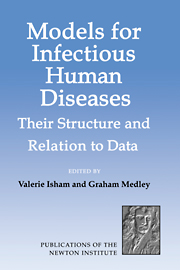Book contents
- Frontmatter
- Contents
- Introduction
- Participants
- Non-Participant Contributors
- Part 1 Transmissible diseases with long development times and vaccination strategies
- Overview of data analysis: diseases with long development times
- HPV and cervical cancer
- An age-structured model for measles vaccination
- Invited Discussion
- Invited Discussion
- Piece-wise constant models to estimate age- and time-specific incidence of toxoplasmosis from age- and time-specific seroprevalence data
- New methodology for AIDS back calculation
- Imperfect HIV vaccines, the consequences for epidemic control and clinical trials
- Feasibility of prophylactic HIV-vaccine trials: some statistical issues
- The design of immunisation programmes against hepatitis B virus in developing countries
- The effect of different mixing patterns on vaccination programs
- Optimal vaccination patterns in age-structured populations I: the reproduction number
- Optimal vaccination patterns in age-structured populations II: optimal strategies
- Part 2 Dynamics of immunity (development of disease within individuals)
- Part 3 Population heterogeneity (mixing)
- Part 4 Consequences of treatment interventions
- Part 5 Prediction
Optimal vaccination patterns in age-structured populations I: the reproduction number
Published online by Cambridge University Press: 04 August 2010
- Frontmatter
- Contents
- Introduction
- Participants
- Non-Participant Contributors
- Part 1 Transmissible diseases with long development times and vaccination strategies
- Overview of data analysis: diseases with long development times
- HPV and cervical cancer
- An age-structured model for measles vaccination
- Invited Discussion
- Invited Discussion
- Piece-wise constant models to estimate age- and time-specific incidence of toxoplasmosis from age- and time-specific seroprevalence data
- New methodology for AIDS back calculation
- Imperfect HIV vaccines, the consequences for epidemic control and clinical trials
- Feasibility of prophylactic HIV-vaccine trials: some statistical issues
- The design of immunisation programmes against hepatitis B virus in developing countries
- The effect of different mixing patterns on vaccination programs
- Optimal vaccination patterns in age-structured populations I: the reproduction number
- Optimal vaccination patterns in age-structured populations II: optimal strategies
- Part 2 Dynamics of immunity (development of disease within individuals)
- Part 3 Population heterogeneity (mixing)
- Part 4 Consequences of treatment interventions
- Part 5 Prediction
Summary
Introduction
There is a vast and well-developed theory for the spread of infectious diseases in randomly mixing populations and in populations structured by age. In general we have the following situation. There is an uninfected stationary state. For certain parameter specifications, i.e. in the case of low transmission rate, fast recovery, or high mortality, this uninfected state is stable. If, say, the transmission rate is increased then there is a bifurcation, the uninfected state loses its stability, and a stable infected state comes into existence. The conditions for stability of the uninfected situation or for the bifurcation, respectively, are usually formulated as threshold conditions. In simple cases the threshold condition is given in such a way that certain quantities describing transmission of the disease, multiplication of parasites etc. exceed other terms describing recovery, death of infected etc. In many cases the quotient of these terms is formed, and the threshold condition assumes the form that a certain quantity is compared to the number one. This quantity has often been interpreted as the basic reproduction number R0, i.e. as the number of cases that will be produced by one ‘typical’ infected individual in a totally susceptible population during its infected period. From this interpretation it is obvious, that the condition for stability should be the inequality R0 < 1. It should be underlined that this interpretation of R0 is not a definition as long as the notion of a typical individual or the underlying averaging procedure has not been specified. Until recently this had been done only for some simple cases of randomly mixing populations.
- Type
- Chapter
- Information
- Models for Infectious Human DiseasesTheir Structure and Relation to Data, pp. 90 - 101Publisher: Cambridge University PressPrint publication year: 1996
- 10
- Cited by

